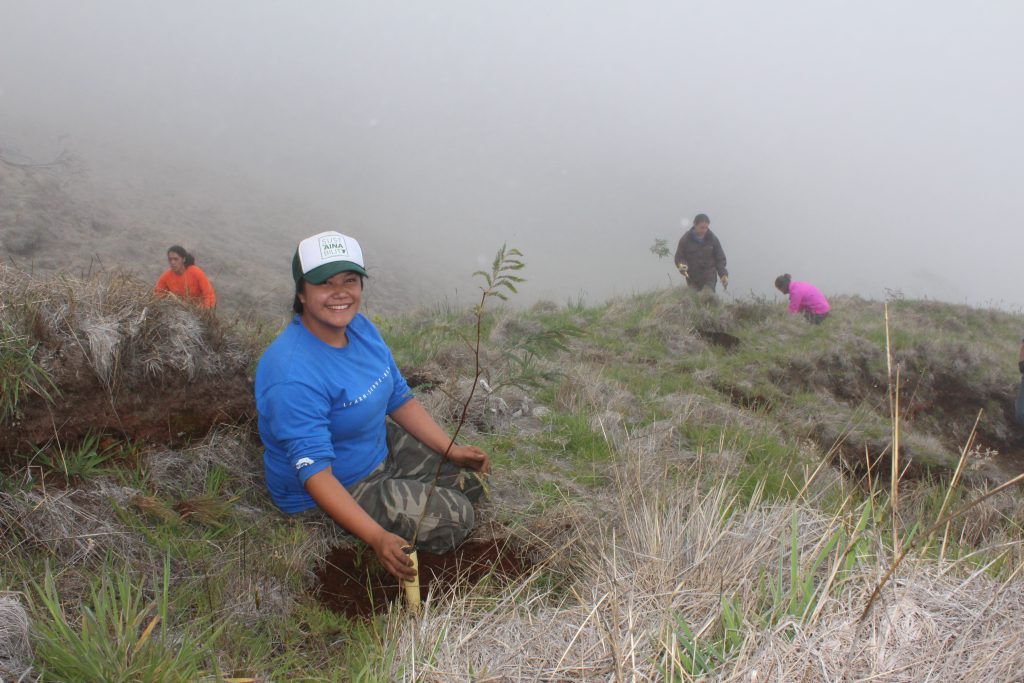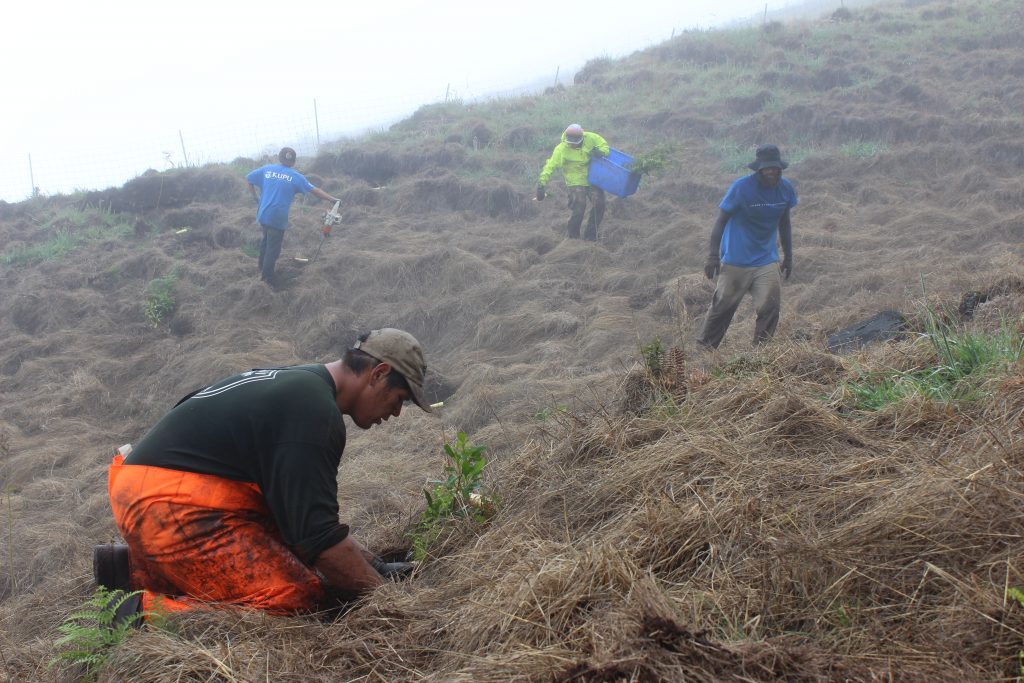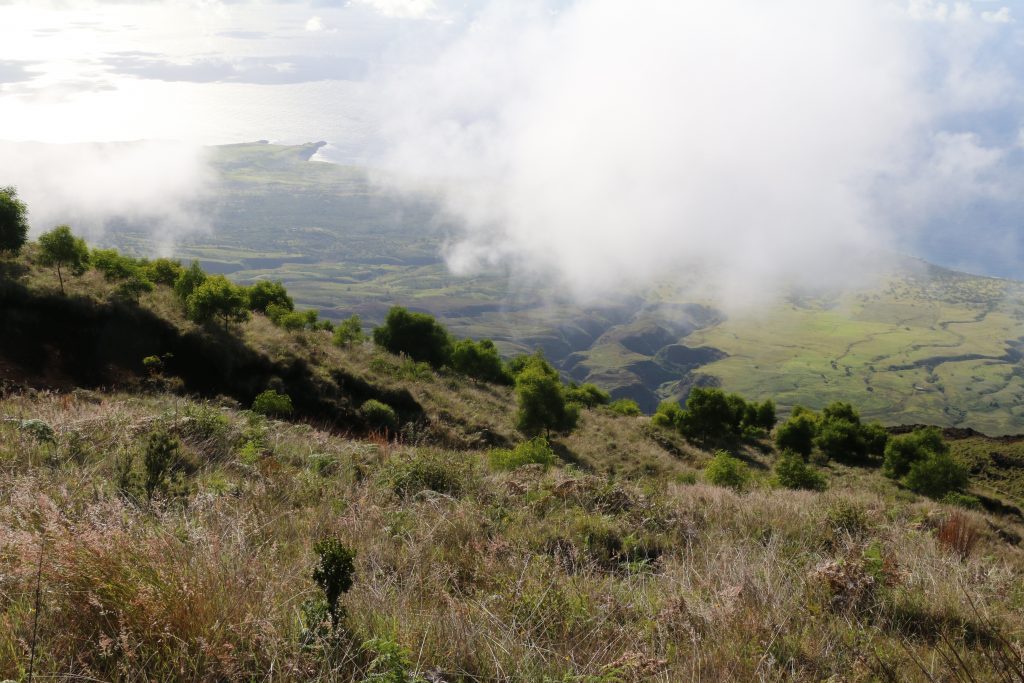State’s First Forest Carbon Offset Project Underway on Maui
Over the past three years, partners have planted 250,000 native trees and shrubs on the Leeward slopes of Haleakalā. It’s part of a watershed partnership involving 11 landowners who want to do their part to restore the native forest.

Na Kula Natural Area Reserve tree planting. Photo credit: Hawai’i DLNR.
Lance DeSilva, DOFAW Maui Forestry Program Manager said, “For me this is really neat to see, I haven’t been out here in probably six months and from the last time I came out here you could barely see the seedlings that our crews have planted. Now that I’m here today I mean it’s evident of how well they are doing here.”
The state is now converting the carbon collected in those trees into offset credits for the state’s first-ever forest carbon sequestration program.

Na Kula Natural Area Reserve tree planting. Photo credit: Hawai’i DLNR.
Philipp Lahaela Walter, DLNR Division of Forestry and Wildlife State Survey and Protection Forester explained, “So whenever we plant a Koa Tree, just like that, with the photosynthesis, it sucks out carbon dioxide, one of the major greenhouse gases that is changing our climate as we speak. And it stores it in biomass.”
The biomass is then quantified and sold in the form of offset credits to those who want to help diminish their carbon footprint.
The DLNR Division of Forestry and Wildlife awarded the contract to Verra, a firm that will certify greenhouse gas emissions at the site.
State officials estimate that reforesting 4,700 acres at Maui’s Kahikinui and Nakula forest reserves will withdraw an estimated 94,000 metric tons of carbon from the atmosphere. The EPA says that’s the equivalent of getting tens of thousands of passenger vehicles off the road in a given year.

Kahikinui Forest Reserve. PC: Hawai’i DLNR.
The forest carbon certification is estimated to cost a total of $150,000. State officials say funds received from the sale of carbon offsets will be re-invested back into the management of the forest. The majority of these costs will go towards the assessment of the project by independent auditors; a smaller portion will cover fees for registration, account opening and maintenance, verification and certification.
By selecting a certification standard, DLNR officials say it ensures a reliable and transparent process and guarantees the environmental integrity of the credits resulting from it.
Verra is one of four standard-setting firms that submitted proposals. Verra manages the Verified Carbon Standard, the world’s largest voluntary program for the certification of greenhouse gas emission reduction projects.
In addition to removing carbon from the atmosphere, officials say the project also provides numerous other benefits to the people of Hawai‘i such as freshwater capture and storage, reef protection by reducing soil run-off, building habitat for endangered species, and decreased wildfire threats by removing fire-adapted invasive plants.
DLNR Chair Suzanne Case noted, “Verra’s selection as forest carbon standard for Kahikinui Forest Reserve and Nakula Natural Area Reserve is an important next step for DLNR and the State of Hawai‘i in addressing climate change. We envision the native forest restored here, along with other project’s like this, can help to move us close to Hawai‘i’s carbon neutral goals.”
Certifying the project under Verra’s VCS, which includes the verification and validation of the project by independent auditors, enables DOFAW to generate certified carbon credits that it, in turn, can sell to interested buyers, brokers, traders, or retailers. Philipp LaHaela Walter, DOFAW’s Resource and Survey Forester, explained, “Purchasing these carbon offsets will also benefit the buyers as it will allow businesses and individuals to offset their carbon footprint while directly contributing to the restoration and protection of Hawai‘i’s amazing forests and reefs.”
This is the first forest carbon project operated by the State. Other areas are being explored to expand the effort. The certification of koa reforestation projects currently show the largest potential for capturing and storing carbon.
DOFAW Administrator David Smith concluded, “There are so many reasons to restore Hawai‘i’s forest, from ensuring we have clean, fresh abundant water for our people, in our streams, and on our reefs to protecting communities from wildfires and providing habitat for wildlife. The expected benefits of this and other projects like it are huge and can make significant contributions toward mitigating climate change impacts.”









